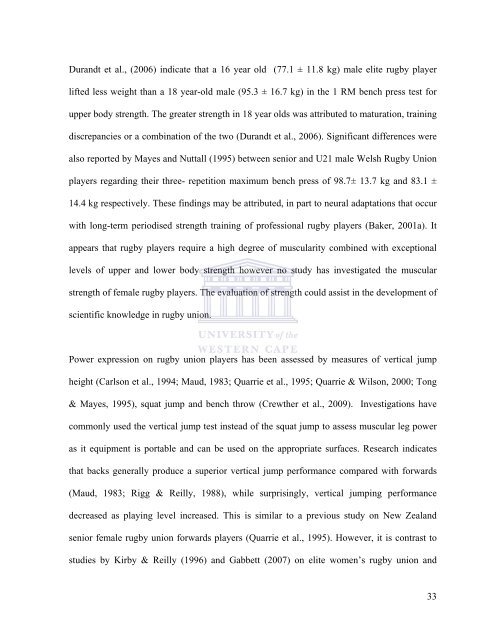Physical fitness of elite women's rugby union players over a ...
Physical fitness of elite women's rugby union players over a ...
Physical fitness of elite women's rugby union players over a ...
Create successful ePaper yourself
Turn your PDF publications into a flip-book with our unique Google optimized e-Paper software.
Durandt et al., (2006) indicate that a 16 year old (77.1 ± 11.8 kg) male <strong>elite</strong> <strong>rugby</strong> player<br />
lifted less weight than a 18 year-old male (95.3 ± 16.7 kg) in the 1 RM bench press test for<br />
upper body strength. The greater strength in 18 year olds was attributed to maturation, training<br />
discrepancies or a combination <strong>of</strong> the two (Durandt et al., 2006). Significant differences were<br />
also reported by Mayes and Nuttall (1995) between senior and U21 male Welsh Rugby Union<br />
<strong>players</strong> regarding their three- repetition maximum bench press <strong>of</strong> 98.7± 13.7 kg and 83.1 ±<br />
14.4 kg respectively. These findings may be attributed, in part to neural adaptations that occur<br />
with long-term periodised strength training <strong>of</strong> pr<strong>of</strong>essional <strong>rugby</strong> <strong>players</strong> (Baker, 2001a). It<br />
appears that <strong>rugby</strong> <strong>players</strong> require a high degree <strong>of</strong> muscularity combined with exceptional<br />
levels <strong>of</strong> upper and lower body strength however no study has investigated the muscular<br />
strength <strong>of</strong> female <strong>rugby</strong> <strong>players</strong>. The evaluation <strong>of</strong> strength could assist in the development <strong>of</strong><br />
scientific knowledge in <strong>rugby</strong> <strong>union</strong>.<br />
Power expression on <strong>rugby</strong> <strong>union</strong> <strong>players</strong> has been assessed by measures <strong>of</strong> vertical jump<br />
height (Carlson et al., 1994; Maud, 1983; Quarrie et al., 1995; Quarrie & Wilson, 2000; Tong<br />
& Mayes, 1995), squat jump and bench throw (Crewther et al., 2009). Investigations have<br />
commonly used the vertical jump test instead <strong>of</strong> the squat jump to assess muscular leg power<br />
as it equipment is portable and can be used on the appropriate surfaces. Research indicates<br />
that backs generally produce a superior vertical jump performance compared with forwards<br />
(Maud, 1983; Rigg & Reilly, 1988), while surprisingly, vertical jumping performance<br />
decreased as playing level increased. This is similar to a previous study on New Zealand<br />
senior female <strong>rugby</strong> <strong>union</strong> forwards <strong>players</strong> (Quarrie et al., 1995). However, it is contrast to<br />
studies by Kirby & Reilly (1996) and Gabbett (2007) on <strong>elite</strong> women’s <strong>rugby</strong> <strong>union</strong> and<br />
33
















